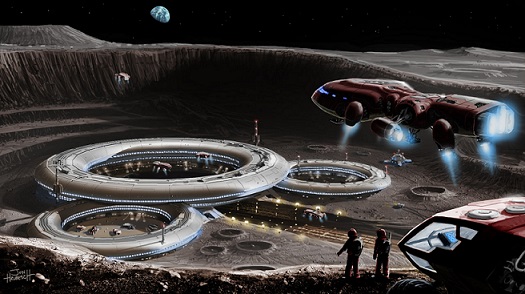
China is set to launch its first independent space station, making it the first country to have its own base on the moon.
The country plans to build its first base on the moon by 2028, with the goal of landing astronauts there in the future. The base will serve as the first outpost on the moon’s South Pole, which is believed to be the ideal location for finding water.
China plans to turn the base into a global research facility. The station will consist of a lander, hopper, orbiter, and rover, with a nuclear system for water extraction and oxygen production.

The lunar base will likely be powered by nuclear energy, Caixin reported. Its basic configuration will consist of a lander, hopper, orbiter, and rover, all of which would be constructed by the Chang’e 6, 7, and 8 missions.
“Our astronauts will likely be able to go to the moon within 10 years,” Wu Weiran, chief designer of China’s lunar exploration program, said in an interview with state broadcaster CCTV earlier this week. Nuclear energy can address the lunar station’s long-term, high-power energy needs, he said.
China has increased its space ambitions, sending probes to the moon, building its own space station, and aiming for Mars. This puts it in direct competition with the US, which has a rover on the Red Planet and is seeking to return astronauts to the moon this decade.
China was the first nation to send a rover to the moon’s far side in 2019 and returned with its first lunar samples. The rover is expected to be larger than the two China-operated rovers on the Moon earlier.
China’s willingness to use nuclear power may be due to its continuous, reliable, unlimited, and affordable energy source. If optimized for powering its lunar base, it will also enable astronauts to generate oxygen and water.
The chief designer did not offer specifics of how he wanted to achieve the goal of developing nuclear power for a lunar base.
However, similar assertions were made last year when Chinese space scientists revealed that they were developing a powerful nuclear reactor for China’s Lunar and Mars missions. The project was started in 2019 with the help of government support.
At the time, the researchers stated that the reactor might produce one megawatt of electricity, making it 100 times more potent than a similar device that NASA hopes to place on the Moon’s surface by 2030.
On its part, NASA announced in November 2021 that it was working on establishing a “durable, high-power, sun-independent” fission reactor on the Moon by 2030.
The Chinese research team told South China Morning Post last year that the engineering design of a prototype machine was completed, and specific crucial components had been produced.
Nuclear energy will support the station’s communications facilities to maintain communication with Earth and power the station’s communications systems. It will also stay connected to the Earth and relay signals between the Earth, Mars, and deep space. China has also announced its desire to explore deep space.
“China was the first country to propose building such a research station at the lunar South Pole,” Wu said. At the latitude of about 89 degrees south, he said there could be 180 consecutive days of light to sustain extended operations for both instruments and astronauts.
China has launched five successful missions, Chang’e 1 through 5 to orbit, land on, and return rock samples from the Moon over the last 15 years, including the first-ever landing of a spacecraft on the Moon’s far side.
“We need to increase the thrust power of our rockets by at least four times to support manned landings on the Moon, the Mars, and mass transport between the ground and near the Earth space,” Wu said.
With the Artemis now taken off and American astronauts expected to make a lunar landing by 2025, the work in China could intensify.
Both China and the US are spending billions of dollars to not just put humans on the moon, but also to access resources that could foster life on the lunar surface or send spacecraft to Mars.
China landed a rover on the far side of the moon in 2019 and collected its first lunar samples. The base aims to be the first outpost on the moon’s South Pole, where scientists believe water is best found. NASA is also targeting this area. China plans to expand the base into an international research station.
To read more such news, download Bharat Express news apps























